AMD Announces Radeon RX 5500 Series: 1080p Gaming for Desktop & Mobile, Coming This Quarter
by Ryan Smith on October 7, 2019 9:00 AM EST- Posted in
- GPUs
- AMD
- Radeon
- Navi
- Radeon RX 5500
Radeon RX 5500M - Discrete SKUs for Discrete Mobile
Shifting gears, let’s talk about the other half of today’s Radeon announcement, the Radeon RX 5500M. Cut from the same cloth as the OEM desktop RX 5500 Series cards, AMD is also going to be using the Navi 14 GPU for mobile products as well. And as a result, I expect this to be a more aggressive mainstream product than in years past from AMD.
As a quick refresher, AMD’s success in the mobile market over the last decade have been uneven at best. AMD’s share of mobile discrete GPUs is notably lower than their share of desktop discrete GPUs, particularly for higher-end solutions that can handle 1080p gaming with few-to-no compromises. It hasn’t been for a lack of effort on AMD’s part – the company went so far as to make a low z-height version of Polaris 11 specifically for laptops – but this hasn’t translated to much success on AMD’s part. Outside of Apple’s laptops, where AMD has an exclusive contract, you’ve likely seen few (if any) gaming laptops with a mobile RX 460/560, and no one beside Apple even used AMD’s Vega 12 (“Vega Mobile”) GPU.
AMD isn’t promising to move the moon and the stars with their latest mobile wares, but the Radeon RX 5500M should be a good step forward for the company. AMD’s energy efficiency is in a much better place right now thanks to TSMC’s 7nm process, and while they still have to overcome the sheer inertia of NVIDIA, a solid offering can turn heads. Helping matters is that Navi 14 is clearly built big enough to do well at 1080p gaming, whereas the Polaris 11 GPUs powering the RX 460/560 were always just a bit too underpowered to do that task without compromises.
With any luck, AMD’s messaging changes will help here as well. As I mentioned earlier, AMD has brought back discrete mobile SKUs; this is a Radeon RX 5500M, not a Radeon RX 5500 put in to a laptop. The difference is somewhat academic since all laptop parts have their clockspeeds adjusted to meet the power/thermal limits of a laptop’s design – so it doesn’t change how OEMs go about configuring their systems – but in most respects it’s clearer messaging. A laptop RX 5500M isn’t going to perform like a desktop RX 5500, and this naming helps that distinction.
| AMD Radeon RX Series Mobile Specification Comparison | ||||||
| AMD Radeon RX 5500M | AMD Radeon Vega Pro 20 | AMD Radeon RX 560X | AMD Radeon RX 460 | |||
| CUs | 22 | 20 | 14/16 | 14 | ||
| Texture Units | 88 | 80 | 64 | 56 | ||
| ROPs | 32 | 32 | 16 | 16 | ||
| Game Clock | 1448MHz | N/A | N/A | N/A | ||
| Boost Clock | 1645MHz | 1300MHz | 1275MHz | 1200MHz | ||
| Throughput (FP32) | 4.6 TFLOPs | 3.3 TFLOPs | 2.6 TFLOPs | 2.2 TFLOPs | ||
| Memory Clock | 14 Gbps GDDR6 | 1.5 Gbps HBM2 | 7 Gbps GDDR5 | 7 Gbps GDDR5 | ||
| Memory Bus Width | 128-bit | 1024-bit | 128-bit | 128-bit | ||
| Max VRAM | 4GB | 4GB | 4GB | 2GB | ||
| Typical Board Power | 85W | ? | ? | ? | ||
| Architecture | RDNA (1) | Vega (GCN 5) |
GCN 4 | GCN 4 | ||
| GPU | Navi 14 | Vega 12 | Polaris 11 | Polaris 11 | ||
| Launch Date | Q4 2019 | 10/2018 | 04/2018 | 08/2016 | ||
At any rate, looking at the RX 5500M, what we find is very much the mobile counterpart to the desktop RX 5500 Series. AMD has kept the same number of CUs (22), but has scaled back the clockspeeds to better fit the TDP needs of a laptop. I won’t rattle off the speeds and feeds here since it’s so close to the desktop parts we just covered, but the 1448MHz game clock is quite promising if practical consumer laptops can sustain that clockspeed.
All told, AMD is claiming that RX 5500M will hit 4.6 TFLOPs, which would be 88% of the performance of its desktop counterpart. And, given that AMD’s performance claims for the desktop part put it at RX 580/590 levels of performance, then ideally this would put the mobile part around desktop RX 570 levels. I say “ideally” because in practice mobile GPUs tend to be clocked lower still (either in configuration or throttling) to match the cooling capabilities of their host system, but even scaled back a little more, this would be a promising level of performance.
Meanwhile, the RX 5500M parts are also retaining the use of GDDR6. I’m still waiting on confirmation from AMD on the memory clockspeed – if it’s 14Gbps or 12Gbps – but even if AMD picks power consumption and takes the latter, this still puts the RX 5500M at 192GB/sec (or better) of memory bandwidth. This will be AMD’s first mobile part with GDDR6, so it’s a big deal there.
Curiously, however, RX 5500M configurations won’t ship with 8GB of memory. Officially, AMD’s specifications only call for 4GB of memory, so the mobile implementation won’t be available with as much memory as its desktop counterpart. Asking AMD about this, it sounds like this is cost-driven, which is something we’ve been seeing since GDDR6 first came available – it’s fast, but it also carries a price premium over GDDR5. In this case, AMD has told me that OEMs consider 4GB the sweet spot in performance versus price, especially as the OEMs look to make their machines attractive to as wide a market as possible. Also helping matters is that 4GB of GDDR6 has somewhat lower power requirements than 8GB. Ultimately, this means that RX 5500M is arguably going to be a bit undersized for AAA games when it comes to memory capacity – necessitating dialing the textures back a level – while AMD’s bread & butter of eSports games are far more forgiving.
Finally, we have TDPs. Being a mobile part, the Radeon RX 5500M will ship with a lower TDP than its desktop counterparts, and in fact it’s much lower. According to AMD the TDP for the top configuration is just 85W, only a bit more than half of the desktop cards’ TDP. This puts the RX 5500M right in the sweet spot for mid-to-high-end gaming laptops, as this is generally where we see GPU TDPs for those machines fall. I fully expect that RX 5500M is getting the best Navi 14 bins here in terms of leakage/power, and the lower clockspeeds help carry the part the rest of the way.
And 85W won’t be the only option for OEMs. AMD has also told me that the RX 5500M is the first time that AMD is offering variable TDPs for OEMs, allowing for OEMs to pick from several TDPs to meet their needs. AMD hasn’t given me an exact range here, but for the market they’re going after I wouldn’t be surprised to see options at 60W, if not lower. Lower TDP options will of course translate to lower performance to match, while allowing OEMs to get RX 5500M into thinner and lighter laptops (think MacBook Pros). Truthfully, I’m not sure how much of a game changer this is for OEMs, since they have shown to be capable of dialing things in on their own, but having official options at least simplifies the process and gives the OEMs a greater degree of support.
OEM Partners & Availability
As today’s announcement is all about AMD getting ahead of OEM announcements, the company and its many partners are also going to be announcing a slew of systems that will either be shipping with the RX 5500 Series or will offer it as an option. The list is too numerous to go through here, but for desktops it includes the usual suspects, from Dell to HP to Acer.
Officially, AMD’s guidance is for RX 5500 Series cards to start showing up in retail systems this quarter (Q4). But digging into their full press release, both HP and Lenovo are slated to begin shipping RX 5500-equipped systems in November, with Acer following that up in December. So we should be seeing RX 5500 desktop cards in some form or another next month.
Meanwhile, on the mobile side of matters, AMD’s lead partner for the RX 5500M will be MSI. A longtime AMD ally, MSI is announcing an all-AMD notebook: the MSI Alpha 15. The company’s latest gaming laptop is a true showcase for AMD technologies, incorporating AMD CPUs, GPUs, and even Freesync capabilities.
For a GPU, the MSI Alpha 15 will of course ship with the new RX 5500M. Meanwhile the CPU is AMD’s Ryzen 7 3750H, AMD’s highest-performing 35 Watt APU. The 35W Ryzen APUs have shown up in a number of systems, however it’s rare (if not refreshing) to see one paired with a faster AMD GPU like the RX 5500M. Finally, the laptop also incorporates FreeSync support, via a 1080p IPS panel that can go up to 144Hz. Finally, the Alpha 15 will likely be the first RX 5500 hardware of any kind to ship – according to AMD, MSI is expected to launch the laptop later this month.
Otherwise, AMD isn’t announcing any other RX 5500M laptops at this time. Given the importance of the MSI deal, I’m not too surprised to see AMD saving the press for their closest partner and their all-AMD machine, but I am curious to see where things go from here. Given the company’s history here, they do have a bit of an uphill climb to get the RX 5500M into more laptops, and thankfully for AMD, this part seems to be better prepared than past mobile SKUs to do just that.
Retail Cards: Coming in Q4
While today’s announcement is focused on OEM systems – an unusual inversion from the usual retail-first style of launches – AMD is also taking a moment to talk about what their plans are for RX 5500 Series retail cards. In short, the company will be releasing retail cards as well, and those will be coming this quarter.
At this point AMD isn’t releasing the full details of the retail lineup – if nothing else, they need to have something to save to announce when they actually start shipping those cards – but the retail cards will clearly be similar to what’s being announced today for OEMs. Given that we know that the OEM cards announced today aren’t using a fully-enabled Navi 14 GPU, it’s a safe bet that either in piecemeal or in whole, AMD will eventually end up with multiple RX 5500 Series cards for retail. The OEM RX 5500M is as good a baseline as anything for a vanilla retail RX 5500, leaving a fully-enabled chip for a potential XT variant.
Otherwise, since we do know so much about the hardware, the biggest question mark at this point will be pricing. AMD has to balance chip yields and GDDR6 costs against factors such as competitive pressure, so while AMD is favoring GTX 1650 comparisons, I’m not expecting the RX 5500 Series to be priced similarly to the $149 card. AMD could yet surprise us all, but as AMD won’t want to leave too big of a gap between the RX 5700 series and RX 5500 series, we’re likely looking at cards priced closer to the RX 570/580.
What we won’t be seeing at any point, however, are reference cards. AMD is telling us up-front that the retail RX 5500 Series launch will not have any reference cards (ala the RX 5700 series), and instead will start day-one with customized designs from the board partners. We may yet see everyone start off with semi-custom designs to bootstrap the process – a reference PCB with a custom cooler – but AMD won’t have a retail reference card. Which is not to say that AMD doesn’t have an internal reference card, as they’ve included what looks to be it in a few shots in their press deck, but that card won’t go to retail. I would not be at all surprised to see OEMs using it, however.
AMD Raise The Game Bundle
Finally, along with the holiday shopping season and parallel to the launch of the Radeon RX 5500 Series, AMD has also launched a new game bundle. Dubbed the Raise The Game Bundle, this covers AMD’s Radeon RX 5700 and RX 5500 series cards, as well as the RX 570/580/590.
For their latest bundle, AMD is giving Radeon video card buyers a choice between two games, both of which AMD is sponsoring and has worked with the developers on. The options for the bundle are Borderlands 3, alongside Tom Clancy's Ghost Recon Breakpoint, the two of which have launched in the past couple of weeks. This bundle is set to run through the end of the year.
| AMD Radeon Game Bundles | |||
| Hardware | Bundle | ||
| Radeon RX 5700 Series Radeon RX 5500 Series |
Raise The Game (One Game): Borderlands 3 or Ghost Recon Breakpoint and Xbox Game Pass for PC (3 Months) |
||
| Radeon RX 570/580/590 | |||
| Radeon VII Radeon Vega Radeon RX 560 |
Xbox Game Pass for PC (3 Months) | ||
AMD’s Xbox Game Pass bundle is also still ongoing, and as part of the Raise The Game bundle has been extended to cover the Radeon RX 5500 series as well. So along with the free game, recent Radeon cards will come with a 3 month trial subscription for that offer as well.
Overall, it’s not unusual to see newly launched video cards bundled with games, but it is uncommon. Typically this is a sign that a manufacturer expects the market segment to be highly competitive – and thus, looking for a value-add edge over the competition – so this is a good indicator that AMD expects things to be busy in the mainstream video card market and OEM system builds for the rest of the year.


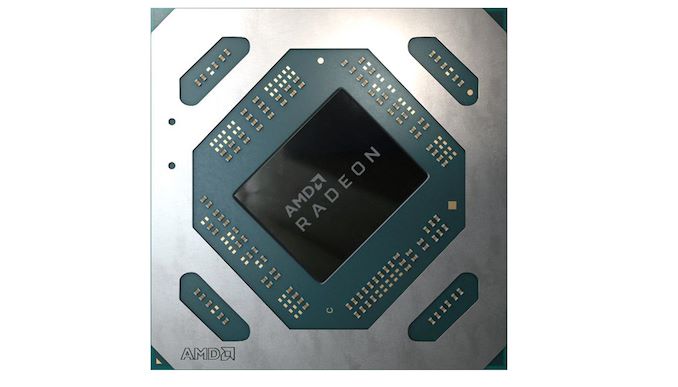
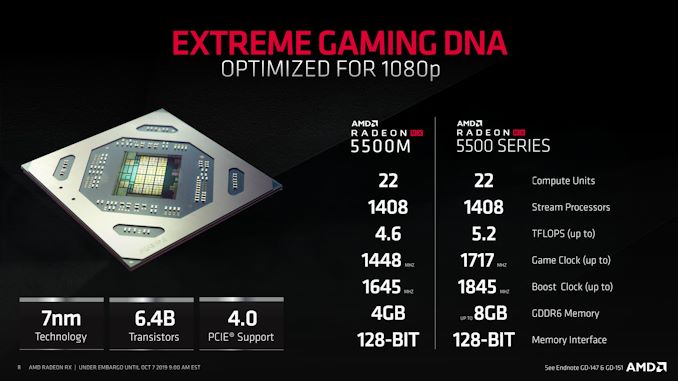
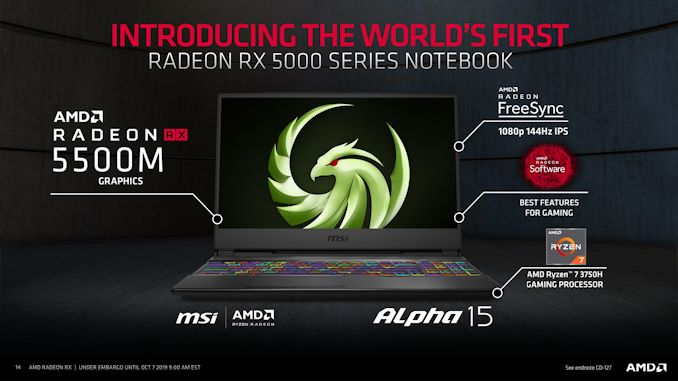
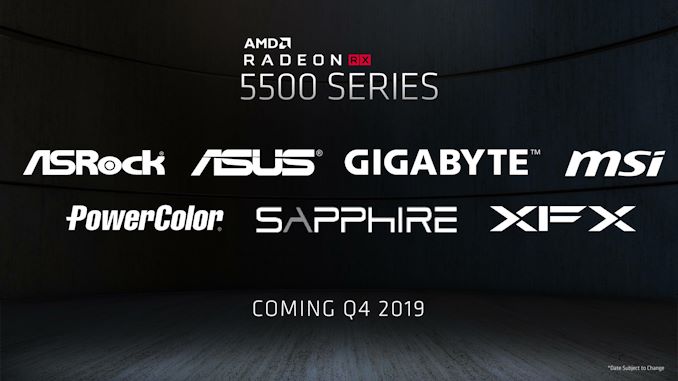





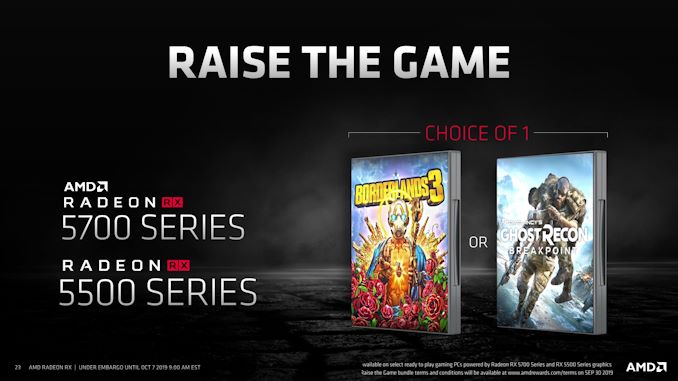














61 Comments
View All Comments
Death666Angel - Tuesday, October 8, 2019 - link
First of all, you can't compare dGPUs and iGPUs when the OP is clearly talking about dGPUs. Secondly, If youre measure of "considerably increased performance per dollar" is paying 15 bucks less for the same performance some 7 years later, I have a bridge to sell you.GreenReaper - Tuesday, October 8, 2019 - link
15 bucks less *and* you get the equivalent of a capable CPU period bundled in as well!Obviously if you already have a CPU or want a more capable one, it isn't for you. But it does say something about progress. Even if it's "AMD can't get the same money for treading water on GPU". (And really, I don't think this is the case; there have been improvements, in power especially.)
ET - Monday, October 7, 2019 - link
I haven't seen any mention of price, and from figures on other sites, it looked like this is closer to Rx 590 performance. Plus RX 580 has a TDP of 185W. So this entire sentence seems to be off.brucethemoose - Monday, October 7, 2019 - link
"If these TGPs are accurate, then this may be another case of AMD favoring absolute performance over performance efficiency for their mainstream parts"It makes sense from a business perspective. I'd guess that most "mainstream GPU" customers aren't particularly interested in power consumption or OC headroom, and AMD gets plenty of room to use the same chip in lower end SKUs. The real cost for AMD is a more expensive PCB and maaaybe long term electromigration concerns, which are easy problems to swallow.
Death666Angel - Tuesday, October 8, 2019 - link
But the stereotype is already "AMD cards are too freakin' loud" and considering AMD board partners often skimp on cooling more than on Nvidia cards, high board power consumption can hurt sales.GreenReaper - Tuesday, October 8, 2019 - link
Right, but that's been the case for a while now. If you want a quiet card, you'll be able to buy it, but it'll be even less powerful. They're aiming for the crowd which wants some performance at a relatively low price, and is willing to deal with sound and (in this case) power usage as part of the cost. They and their board partners are kinda stuck with the lower end of the market because they simply can't provide an equivalent product at an equivalent price - yet.mikato - Monday, October 21, 2019 - link
Yes, as long as they keep the PSU requirement somewhere around 500 watts and it doesn't get out of hand with heat and noise. If it worked before, and is doable with the new gen, then why not? My Sapphire Nitro RX 580 is nice and quiet. 580 was a very successful GPU, so use that as a guide.Davenreturns - Monday, October 7, 2019 - link
I'm seeing incorrect specs being reported more and more by my favorite hardware review sites. It's very depressing.https://www.amd.com/en/products/graphics/amd-radeo...
The typical board power is 110W. The ROPs are 32. This is direct from AMD and not some rumor.
Yojimbo - Monday, October 7, 2019 - link
Your favorite hardware review sites got it directly from AMD, too, not from some rumor.MikhailT - Monday, October 7, 2019 - link
You may want to refresh, it saysTypical Board Power (Desktop) 150 W
for me.